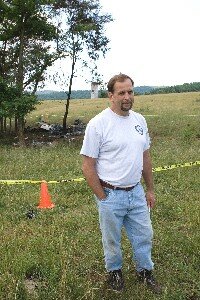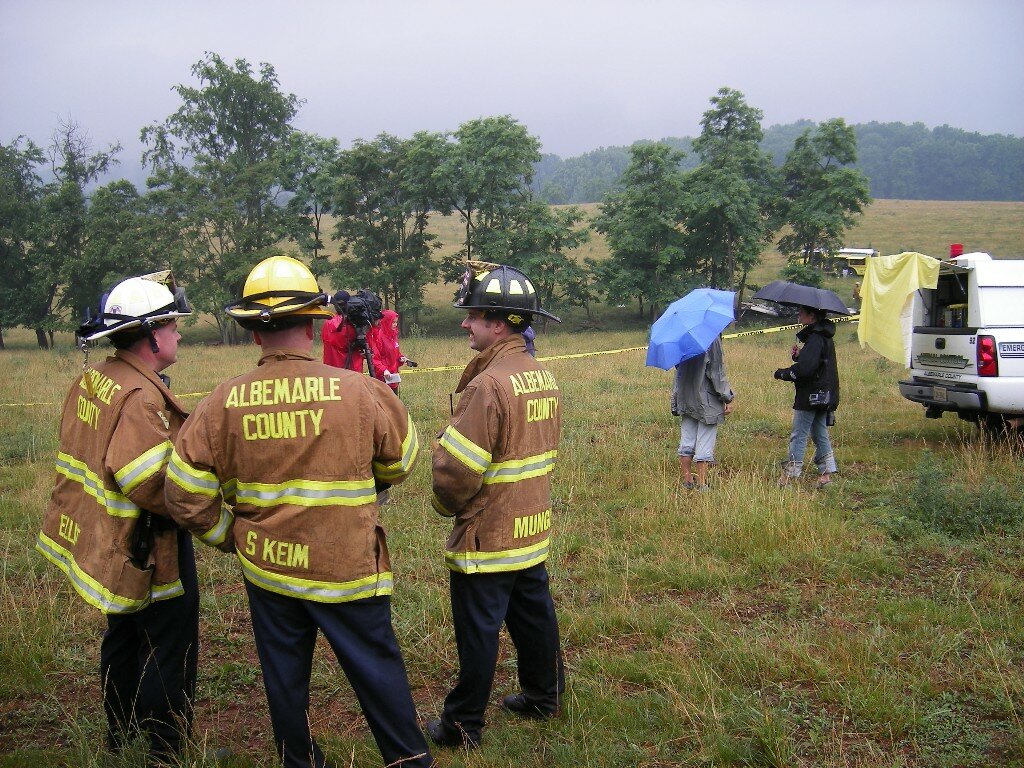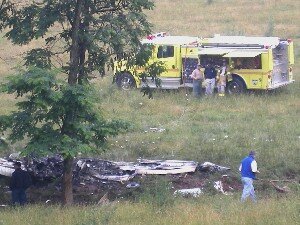NEWS- Qroe quandary: Cause of crash shrouded in fog
The pilot of plane number N202EN headed south along the Eastern Seaboard, the occupants planning to land at property they had purchased four months earlier. Two days before the flight, they had unveiled development plans, and now, winging toward the property in southern Albemarle County, the pilot made contact with federal air-traffic controllers in Flint Hill. But by the time the first unit from the North Garden Volunteer Fire Department arrived at the fog-encased cow pasture along Plank Road shortly after 11:30am on June 14, their trip had ended with a flame-engulfed wreckage, two lives lost, and a novel development thrown into question.
***
Last spring, longtime Albemarle resident Fred Scott invited neighbors of his North Garden-area farm into his house to meet a couple of developers from New Hampshire. "The first moment when I said I'd sold my farm for development, you could have heard a pin drop," says Scott. "There was even some crying."
The grandson of legendary UVA benefactor Frederick W. Scott of Scott Stadium fame, the younger Scott says that Bundoran has been in the family since 1940, and thanks to its role in raising Belgian draft horses and hosting the Albemarle County Fair, the 2,300-acre tract has become a beloved source of pride whose exploitation might excite horror among growth-wary neighbors.
"But as soon as David Brown and Robert Baldwin started talking, my neighbors looked them in the face and trusted them," Scott recalls. "In less than an hour, my neighbors– wealthy and not-so-wealthy– took these men's measure and decided they were real. And they were all devastated when they died."
Brown, 55, and Baldwin, 75, perished in the fiery wreckage of Brown's 1996 Beechcraft Bonanza, about four-tenths of a mile from the tiny airstrip onto which they'd attempted to land. Purchased in January for $30.8 million, the land could conceivably have been become over 160 building lots, but their company, Qroe Farm Preservation Development, planned to create just 88 homesites– with nearly 90 percent of the land preserved or placed into permanent conservation easements. Will the plans for the property go forward?
"Until they're laid to rest, I hesitate to even talk about that," says Susan Payne of Payne Ross and Associates, the marketing firm that assisted their efforts. "It's a monumental loss."
***
The morning weather was clear in New Hampshire when Brown arrived. He had flown up to Nashua Municipal Airport, long known as Boire Field, from his home in West Hartford, Connecticut to pick up Baldwin in the nearby town of Derry, where Qroe's offices are based. According to an official with GFW Aeroservices, Brown refueled at 7:22am. As the single-engine aircraft took off at 8:11am, says airport manager Royce Rankin, the weather was clear. "It was nice up here," he adds. To the south, however, a storm was brewing.
Payne says the men were in Albemarle "all the time" to meet with public officials, investors, and media. Baldwin, a Harvard graduate, won fans for his preservation-minded method of putting houses on farms. Brown, whose daughter Pamela graduated last month from UVA, visited so frequently, Payne says, that he recently joined Farmington Country Club.
Brown had deep roots in Virginia soil. He was a member of the Ingalls family who owned the Homestead Resort in Hot Springs for much of the 20th century before selling it in 1993. In 2002, they also sold a 12,300-acre tract around the Homestead, and of that, more than 9,000 acres went to the Nature Conservancy to be preserved. Nonetheless, Payne notes, David Ingalls Brown continued to own property in the Hot Springs area.
***
So what about the airplane? A Salon columnist recently repeated the pejorative "doctor killer" to describe the old Bonanza, a high-performance plane with retractable landing gear and a unique, V-shaped tail. With a cruising speed of over 160 knots, the plane has been a popular model with busy doctors, lawyers, and business execs. But even though that V-tail was retired in the mid-1980s, some worries about the new Bonanza– or at least its pilots– have continued.
The Aircraft Owners and Pilots Association, AOPA, notes that the while a cheaper competitor, the Cessna 210, has experienced just 23.4 fatal accidents per thousand planes, the Bonanza has suffered nearly twice the wrecks, 51.7 fatal accidents per thousand planes. AOPA spokesperson Kathleen Vasconcelos, however, cautions that the figures represent all accidents– not just those caused by mechanical failure.
Mike Turner, a spokesperson for Raytheon, the company that now owns Beechcraft, disputes such comparisons. "It's kind of like comparing apples to oranges," says Turner, noting that the relative rarity of Bonanzas means that a few accidents can skew the figures. Turner notes that the Bonanza will celebrate 60 years of continuous production next year, a record in the industry. "For piston airplanes," he says, "the Bonanza is the pinnacle airplane everyone would like to buy."
Everyone who has at least three-quarters of a million dollars, that is. At a significantly higher price than the Cessna, the Bonanza has long attracted upscale buyers interested in speedily zipping from one place to another. That, however, can be dangerous.
The number-one cause of private plane crashes is pilot error, according to the AOPA Air Safety Foundation, which even has a name for one of the most frequent underlying causes: get-there-itis.
"The determination to reach a destination, combined with hazardous weather, claims the lives of dozens of pilots and their passengers yearly," says the Foundation. "Sometimes, when pilots are waiting out cloud cover, the fact that it lifts from over the airport can mislead many to assume that conditions will be the same in the surrounding area."
Get-there-itis was widely blamed for the 1999 crash that claimed the lives of publisher-pilot John F. Kennedy Jr. and his wife and sister-in-law. In that infamous accident, Kennedy, who did not have an instrument rating, is believed to have become disoriented in the darkness over the Atlantic as he and his passengers hurried to a wedding on Martha's Vineyard.
Charlottesville-Albemarle Airport, which does offer instrument support for its many commercial and private users, was never contacted by the Bundoran developers' ill-fated flight, says CHO spokesperson Terrie Dean.
It's been noted that last week's crash occurred in rain and fog, conditions that sometimes require instrument landings. A search of the FAA database indicates that Brown– besides having a commercial pilot's license enabling him to fly both single- and twin-engined planes– was instrument-rated.
Bundoran, however, without a tower, is not equipped for instrument landings. The unlighted, unmanned airport is really just a 3,000-foot-long mowed grass strip with a faded windsock. FAA spokesperson Jim Peters says the flight was cleared for a visual approach. "Our controllers at Vint Hill use ground radar," says Peters. "We clear them for visual."
Assistant state climatologist Jerry Stenger says that remnants of tropical storm Alberto were pulling moisture from the coast at the time of the crash. "It certainly was not a mystery that there would be poor visibility and wet conditions," says Stenger. "There's not a forecaster on earth who would have missed that one."
Stenger points to a map showing a front passing through Virginia as well as a chart showing overcast conditions at 1,300 feet and a layer of broken clouds at 700 feet. Stenger mentions that rain and mist may have limited visibility to just two miles.
Early on in the investigation, a witness who lives nearby told investigators that shortly before the crash she heard– but could not see– a plane circling the air strip. The woman dialed 911 after hearing the crash, according to County spokesperson Lee Catlin. The Hook attempted to speak with a young man in a house adjacent to the strip, but he declined to be interviewed.
Because the charred wreckage in the field was mostly flattened, with debris confined to an area immediately adjacent to the site and no apparent damage to nearby trees, it appears that the plane did not crash land, but– for whatever reason– plummeted from the sky.
As investigators sort through the rubble at Bundoran Farm, questions remain. The FAA's preliminary report claimed the plane hit overhead wires before the crash, but the on-site investigator from the National Transportation Safety Board isn't so sure.
"Do you see any wires around?" asks senior investigator Paul Cox, as he surveys the rolling fields surrounding the yellow-taped crash scene. In fact, there are no overhead wires visible from the scene. Aside from a few trees, the highest objects nearby are two dilapidated structures– a silo and a barn, each at least 100 yards from the crash.
The NTSB's on-site work ended Friday, June 16, according to Cox, who oversaw a recovery team that arrived to transport the wreckage to a storage facility in Clayton, Delaware for further testing. A preliminary report will be released on the NTSB website in the next several weeks followed by a factual report in four to six months, Cox says. A final ruling on the cause of the crash may take up to a year.
"We want to do a good job," Cox explains, "and there are other accidents ahead of this one."
Fred Scott says he and his 91-year-old mother will continue to live at Bundoran. On his website, the avid pilot tells tales of close calls and big adventures in his own twin-engine Beechcraft Baron. But he declines to talk about the crash. As for the development, he says, "I have a great deal of confidence that it'll all go forward in an orderly way."
– Courteney Stuart contributed to this report

NTSB investigator Paul Cox
PHOTO BY WILL WALKER
Firefighters and the local media survey the scene along Plank Road
PHOTO BY HAWES SPENCER
Fred Scott walks away from the wreckage
PHOTO BY HAWES SPENCER
#

